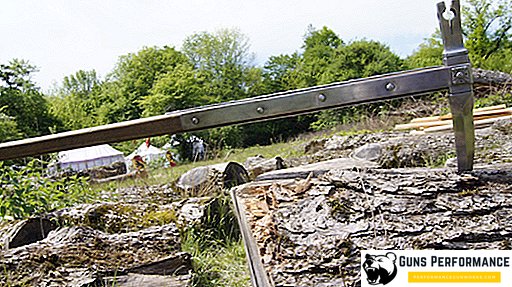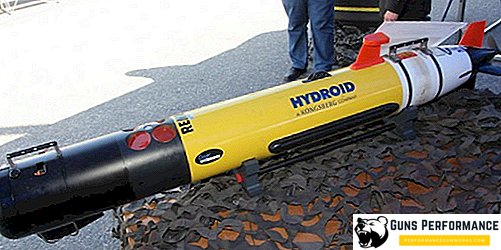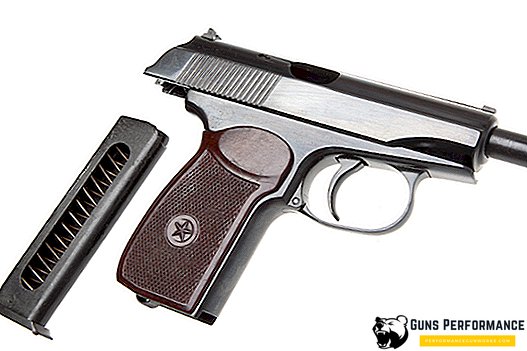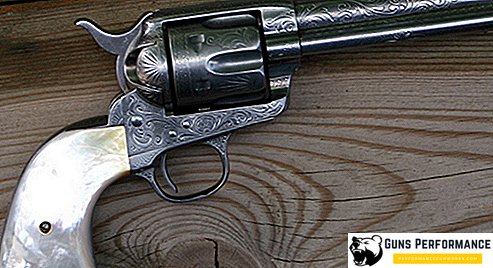
A war hammer is a type of melee weapon designed to deliver crushing blows to an enemy, functionally similar to a mace or club. Together with a spear and an ax, the war hammer belongs to the most ancient types of cold weapons, all of which were invented by man in the Neolithic period.
The war hammer was very popular in the German lands (until the 11th century), it is believed that it was from there that it came to other European countries. However, the "golden age" for the hammer can be called the late Middle Ages, the time of widespread plate armor. During this period, the war hammer — along with the ax and lance — became part of a universal long-rifle weapon, with which it was possible to deliver piercing, slashing and crushing blows. After the disappearance of lamellar armor, the war hammer was used for some time as a status attribute of the military authorities.
In addition to Europe, war hammers were very popular in the East. Varieties of these weapons have been widely used at various times in India, Persia, China and Afghanistan.

The hammer, as, indeed, other types of cold arms, in different historical periods had (and has) great symbolic significance. He is very widely represented in the mythology of various peoples of the world.
The war hammer is the real quintessence of pressure, pressure, power and brute force, invincible and all-overwhelming. However, it is characterized by a peculiar dualism, since the hammer is not only an instrument of destruction, but also an instrument of creation. This is not only an attribute of war, but also a symbol of labor and creativity. The Scandinavian god of thunder and storm Thor used his stone hammer Mjollnir both as a constructive tool and as a weapon of great destructive power. This hammer not only flew well, but always returned to its owner. In Japan, the hammer was a symbol of wealth and prosperity, this tool was a constant attribute of the Greek god Hephaestus - the patron of blacksmiths and metallurgists. However, in some nations the hammer was a symbol of evil, a blind natural element, unpredictable and inexorable.

The hammer is a very common heraldic symbol, although its "peaceful" hypostasis is more commonly used in this area. A sickle with a hammer was present on the coat of arms of the Soviet Union; this symbol and other lovers of the left ideology were often used.
Description of war hammers
Warhammer (eng. Warhammer) - is predominantly a western term, in the domestic literature, this weapon is often referred to as the nail or chase. Although the "chisel" is often called a small hatchet with a hammer on the butt. A large number of types of war hammers that existed in different historical periods, as well as the practice of using hammers as part of a universal warhead, together with an ax and a cusp, led to some confusion in the names.

The war hammer consisted of a shaft and a warhead fixed on its top. The length of the shaft could be different, sometimes it reached a meter long. However, short hammers designed to hold with one hand were also very common. The shaft was usually made of wood (its thickness could vary), but there are also hammers with a metal handle. The warhead had the shape of a parallelepiped or a cylinder, one of the ends of which was pointed. For its attachment to the pole, a variety of methods were used: stopper, rope, and others. The flat part of the striker was called the butt, sometimes it ended in several teeth.
The blunt side of the hammer could stun the enemy, break his bones without even breaking through the armor. And for punching the armor or chain mail, the pointed part of the weapon was used, which was often called the beak.

Bec de Corbin, the Swiss hammer, better known as the Lucerne hammer, had four spikes of considerable length on the butt, separated from the central axis of the striker.
The phrase "war hammer" usually causes an association (for which you need to thank computer games) with a huge and heavy weapon that resembles an ordinary blacksmith's tool. This is not entirely true. By the way, similar delusions are connected with another type of strike weapon - the mace. Perhaps, in some circumstances, on the battlefield, and used heavy blacksmith hammers, but the war hammer, created specifically for military affairs, was very different. As a rule, these weapons fencing with one hand, and its weight was 1-2 kg. But in general, we can add that the war hammers did not resemble what we used to understand by the word "hammer". The main function of this weapon during the period of its greatest spread was the defeat of a well-defended enemy. In some types of war hammer that have survived to our days, the hammer itself was not at all.

What are the main advantages of a war hammer, over other types of cold weapons? There are several of them. First of all, it is the breakdown force of the hammers. After the appearance of plate armor, the sword began to turn more and more into an attribute of status, since it was very difficult to hit the enemy with iron. In the hammer, the center of gravity is much higher than that of the sword, so the blow is much more crushing. In addition, all his strength is concentrated in one point, so to break through the lat does not need to have very great power.
The hammer has another virtue before a spear, ax, or sword: it never gets stuck. This is especially important during a duel with a shield bearer. In a wooden shield, almost any weapon gets stuck, but not a hammer. The fact is that when struck, he punches not so much as breaks through an obstacle, forming a rather wide opening. Possessing sufficient strength and skill, it is possible to split the shield with several successful blows.

The battle hammer had another significant advantage over the sword: it was much cheaper. In the Middle Ages to make a long and durable blade of the sword was a whole story. This required good quality iron and high blacksmith skills. Therefore, swords cost dearly and were not as common as modern cinema shows. In addition, the blade of a sword can get damaged (or even break) from a good blow, and not with each of them can be managed with the help of a whetstone. A hammer (like a mace) is a completely different matter. Steel for the warhead, you can take the middle, and even very average. If during use marks appear on it, then they will in no way affect the fighting qualities of the weapon.
Why then did not the war hammers and maces supplant expensive and not very reliable swords? Alas, like any specialized weapon, the hammer has a number of flaws.
The hammer was extremely difficult to beat the blows of the enemy. For this, he does not have a very suitable balance, moreover, the handle of this weapon does not prevent the opponent’s blade from sliding. So the warrior needed a shield. Also, the war hammer is not very well suited for use in close ranks, they are not very good at long distances.

Medieval war hammers can be divided into three large groups:
- Short hammer or "rider's hammer". This one-handed weapon, which was very popular with cavalry from the XIII to XVI century. It had a length of 60-80 cm, the warhead weighed about half a kilogram. In Russia, the short hammers were traditionally called "klevtsy" or "chisel", they were loved by the Zaporozhye Cossacks (kelef, kelep) and the famous Polish hussars. The beak is often supplemented with a small ax and a spike. The short hammer was used not only by riders, they were also used with pleasure for close-to-hand melee combat;
- Long or long-range hammer. This type of weapon had a pole of considerable length, from 1.2 to 2 meters. Long-range hammers have been widely adopted since about the middle of the 14th century. This type of weapon in many ways resembled a halberd, but differed from it in that its combat unit was not solid-forged, but consisted of individual elements. Their composition differed: very often a similar hammer at the end had a peak, and an ax was installed instead of a beak. Such weapons are more commonly known as the Polax. The surface of the hammer often had teeth, sometimes it was inscribed. There are variants of a long hammer, in which the warhead, besides the ax, bore another beak, four spikes and a hammer, and on top was a peak. Often on the pole of long hammers to protect the hands did the guard (Rondel);
- Throwing hammer. Separately, you can select hammers, designed for throwing at the enemy. They are very similar to the sports equipment used today by Olympians.
Battle hammer history
As mentioned above, the hammer - along with a spear and an ax - is the most ancient type of cold weapons, invented by man. When our distant ancestor realized that nature had endowed him with not too strong and long hands, and his teeth were poorly suited for self-defense, he began to arm himself. The idea to attach a massive stone to a wooden stick is not too complicated, so it is not surprising that the war hammer appeared in the Neolithic period.

And the hammer is also good for its versatility, it can be used not only as a weapon, but also to perform a variety of economic functions. Often the hammer was a butt of a stone ax, in this case the range of its use expanded even more.
After the discovery of metals by man, the tops of the hammers began to be made of them. First from bronze, and then from iron. Moreover, the hammer was necessary in the processing of metals in the forge, so it was very common. Later, already in the Middle Ages, ordinary forge hammers were sometimes used in combat, pushing them onto longer arms.

The hammer was a traditional weapon of the ancient Germans, they used it even before the beginning of the XI century. With the advent of plate armor, the victorious march of these weapons begins throughout Europe. If up to this point a sword or spear was enough to defeat the enemy, then something else was needed to break through the heavily armed. War hammers also had excellent "armor-piercing" characteristics, so they coped well with similar tasks. However, they were not too difficult to use and inexpensive. In its action, the hammer is very similar to a mace, but it is more effective against heavy armor. In addition, additional elements of his warhead significantly increased the versatility of these weapons.
That is why the short hammer became the favorite weapon of infantry and cavalry. The knights long disdained the despicable weapon of the townspeople, but in the end, the harsh reality did not leave them any choice. Already by the middle of the 15th century, the war hammer was becoming a regular rider’s weapon, for which it gets its second name, the “cavalry hammer”.

The infantry went a slightly different way, at the beginning of the 14th century hammers with a pole appeared, sometimes reaching two meters in length, and a hammer, a spear, and an ax could be included in the warhead. Sometimes the lower part of the shaft ended with a deadly spike.
Although, such weapons are usually referred to as a hammer, rather, it is a hybrid of a spear, an ax and a hammer. The classification of such chimeras is a rather complicated question, since there were a large number of variations, and each master made a weapon according to his own understanding - there wasn’t yet a GOST system.

In Germany, such hammer-and-spear axes were called fusstreithammer, in France - bec de corbin, in Switzerland - Lucerne hammers, and in England - polixes (poleaxes). It is the latter name that is the most popular today. Such a weapon combines the hammer's hammering force, a penetrating spear strike and a wide ax-area. With it, the foot warrior was very comfortable to repel the attacks of enemy cavalry.
Some of the modern historians generally believe that the Polax came not from a war hammer, but from a Danish ax.
By the way, the Polax was not only used in the war, it was one of the most popular tournament weapons. They were often used during duels, there was even a special "duel" modification of this hammer.

Practically all the samples of polox that have come down to our days are richly decorated and rather solidly made, which suggests the material prosperity of their owners. Already today, studies of the graves of warriors who fell in the battles of Visby (1361) and Tauton (1461) were conducted, which showed a significant number of deaths precisely from the blows of polix.
The wide spread of firearms gradually makes unnecessary heavy plate armor, along with him goes into oblivion and the war hammer. Although, of course, this does not happen immediately. In the 16th century, a combined weapon appeared: swords, rapiers, and knives were placed in the arms of brakes and war hammers. Sometimes they are used as a stand for firearms. The so-called brandestoks generally had blades that were fired from the handle. Very curious were the so-called crickets - a kind of hybrids of pistols and war hammers.
At the end of the 17th century, the war hammer almost completely lost its combat significance and turned into a fashionable attribute that emphasizes the high status of its owner. He was worn by officers, and the robber atamans often followed their example. So it was in Germany and Italy. In Poland, the nail turned into a civilian weapon of self-defense, called the pickaxe or the butt. For similar purposes, hammers used in Belarus and Hungary.













